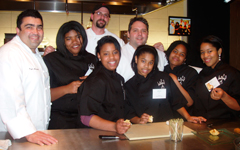Jet-Setting Around the World
Jet-setting around the world is a dream many of us have. And thanks to food, we have the opportunity to experience brand new cultures and countries right from our very own homes. Here at Brainfood, we are ‘traveling’ to different countries and the ride is about to get wild.
Our first stop: Jamaica. Well known for its vibrant colors and spiciness, Jamaican food has a unique mixture of tastes from the rich native history and colonizing countries. The coconut crop from the Spanish, porridge and sweets from the British, and curry from the Indians showcase the influences from many different cultures worldwide. And at the root of the cuisine, is the strong history of the Maroons (Jamaican slaves who were able to escape into the mountains during British power) and their survival.
In class, we were able to create a small sample of traditional Jamaican food. We made coco bread, curry shrimp with rice and peas, and steamed cabbage. Tasting these delicious dishes opened a portal into a different culture, where we could explore and appreciate our differences. One of the best things about being a Brainfood instructor is watching our Brainfoodians open up to something foreign and embrace something new.
As we were going through the lesson, I heard remarks such as, “Wow, that is so interesting!” and “That is mind blowing!” Conversations about their experiences with Chinese food and how it is different from what they have eaten here in the United States continued throughout class; and hearing students make these comparisons about food was a strong reminder to me that there are many ways to explore new ideas and cultures.

Learning and teaching about different countries makes me really think back to my family and cultural background, as Passover just began. Passover is an eight-day holiday celebrating the Jewish peoples’ freedom from slavery in Egypt. I once spoke with a Rabbi about the deeper meanings of the Passover story. One piece of his commentary really stuck out to me: As the Jewish peoples were walking through the parted sea, there were 12 paths (one for each tribe of Israel). While they were traveling through these parted paths there were windows in the walls of the sea; those windows were to make sure that each individual was not focusing solely on their own silo but recognize that there were infinitely more people walking down a different path at the same time.
This interpretation not only enhances my understanding of Passover, but reminds me of what our Brainfoodians are doing in present times. They are opening themselves up to new experiences and reminding themselves that there are many more people in the world who are going through life on a different path at the same time. Many of our students have learned about countries in history class at school, but have not had hands-on, experiential learning about their cultures. Creating and trying dishes from places around the world has given them a deeper connection to these cultures, and a new way to understand.







Comments
Post new comment